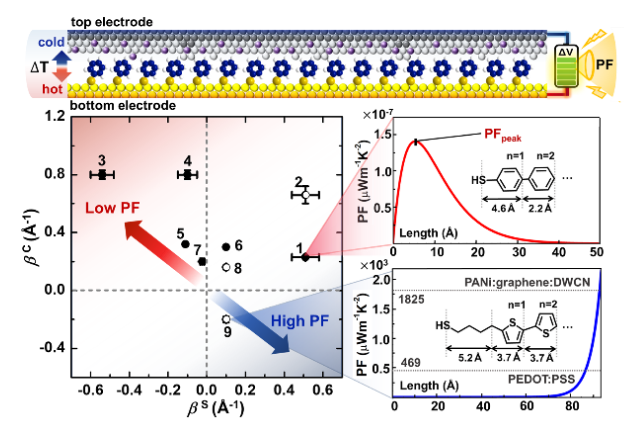

박소현 (제1저자, 통합과정) 강서현(공동 제1저자, 통합과정)
There is a rapidly increasing interest in organic thin film thermoelectrics. However, the power factor of one molecule thick organic film, the self-assembled monolayer (SAM), has not yet been determined. This study describes the experimental determination of the power factor in SAMs and its length dependence at an atomic level. As a proof-of-concept, SAMs composed of n-alkanethiolates and oligophenylenethiolates of different lengths are focused. These SAMs were electrically and thermoelectrically characterized on an identical junction platform using a liquid metal top-electrode, allowing the straightforward estimation of the power factor of the monolayers. The results show that the power factor of the alkyl SAMs ranged from 2.0 × 10–8 to 8.0 × 10–12 μW m–1 K–2 and exhibited significant negative length dependence, whereas the conductivity and thermopower of the conjugated SAMs are the two opposing factors that balance the power factor upon an increase in molecular length, exhibiting a maximum power factor of 3.6 × 10–8 μW m–1 K–2. Once correction factors about the ratio of effective contact area to geometrical contact area are considered, the values of power factors can be increased by several orders of magnitude. With a newly derived parametric semiempirical model describing the length dependence of the power factor, it is investigated that one molecule thick films thinner than 10 nm composed of thiophene units can yield power factors rivaling those of famed organic thermoelectric materials based on poly(3,4-ethylenedioxythiophene)/polystyrenesulfonate (PEDOT/PSS) and polyaniline/graphene/double-walled carbon nanotube. Furthermore, how the transition of the transport regime from tunneling to hopping as molecules become long affects power factors is examined.

 Bright ligand-activatable fluorescent protein for high-qualit...
Bright ligand-activatable fluorescent protein for high-qualit...
 An Emerging Molecular Design Approach to Heavy-Atom-Free Phot...
An Emerging Molecular Design Approach to Heavy-Atom-Free Phot...

















